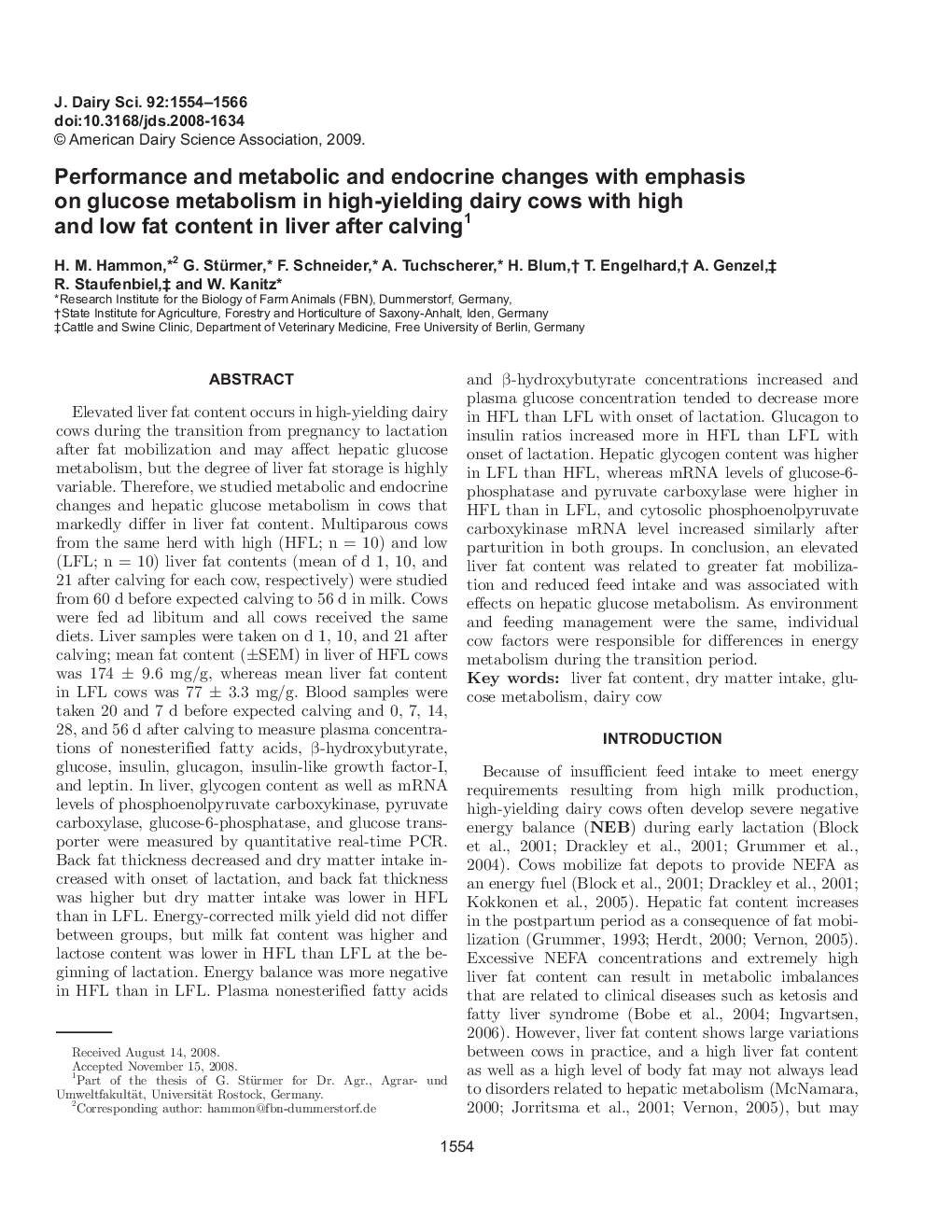| کد مقاله | کد نشریه | سال انتشار | مقاله انگلیسی | نسخه تمام متن |
|---|---|---|---|---|
| 2439172 | 1108091 | 2009 | 13 صفحه PDF | دانلود رایگان |
عنوان انگلیسی مقاله ISI
Performance and metabolic and endocrine changes with emphasis on glucose metabolism in high-yielding dairy cows with high and low fat content in liver after calving1
دانلود مقاله + سفارش ترجمه
دانلود مقاله ISI انگلیسی
رایگان برای ایرانیان
کلمات کلیدی
موضوعات مرتبط
علوم زیستی و بیوفناوری
علوم کشاورزی و بیولوژیک
علوم دامی و جانورشناسی
پیش نمایش صفحه اول مقاله

چکیده انگلیسی
Elevated liver fat content occurs in high-yielding dairy cows during the transition from pregnancy to lactation after fat mobilization and may affect hepatic glucose metabolism, but the degree of liver fat storage is highly variable. Therefore, we studied metabolic and endocrine changes and hepatic glucose metabolism in cows that markedly differ in liver fat content. Multiparous cows from the same herd with high (HFL; n = 10) and low (LFL; n = 10) liver fat contents (mean of d 1, 10, and 21 after calving for each cow, respectively) were studied from 60 d before expected calving to 56 d in milk. Cows were fed ad libitum and all cows received the same diets. Liver samples were taken on d 1, 10, and 21 after calving; mean fat content (±SEM) in liver of HFL cows was 174 ± 9.6 mg/g, whereas mean liver fat content in LFL cows was 77 ± 3.3 mg/g. Blood samples were taken 20 and 7 d before expected calving and 0, 7, 14, 28, and 56 d after calving to measure plasma concentrations of nonesterified fatty acids, β-hydroxybutyrate, glucose, insulin, glucagon, insulin-like growth factor-I, and leptin. In liver, glycogen content as well as mRNA levels of phosphoenolpyruvate carboxykinase, pyruvate carboxylase, glucose-6-phosphatase, and glucose transporter were measured by quantitative real-time PCR. Back fat thickness decreased and dry matter intake increased with onset of lactation, and back fat thickness was higher but dry matter intake was lower in HFL than in LFL. Energy-corrected milk yield did not differ between groups, but milk fat content was higher and lactose content was lower in HFL than LFL at the beginning of lactation. Energy balance was more negative in HFL than in LFL. Plasma nonesterified fatty acids and β-hydroxybutyrate concentrations increased and plasma glucose concentration tended to decrease more in HFL than LFL with onset of lactation. Glucagon to insulin ratios increased more in HFL than LFL with onset of lactation. Hepatic glycogen content was higher in LFL than HFL, whereas mRNA levels of glucose-6-phosphatase and pyruvate carboxylase were higher in HFL than in LFL, and cytosolic phosphoenolpyruvate carboxykinase mRNA level increased similarly after parturition in both groups. In conclusion, an elevated liver fat content was related to greater fat mobilization and reduced feed intake and was associated with effects on hepatic glucose metabolism. As environment and feeding management were the same, individual cow factors were responsible for differences in energy metabolism during the transition period.
ناشر
Database: Elsevier - ScienceDirect (ساینس دایرکت)
Journal: Journal of Dairy Science - Volume 92, Issue 4, April 2009, Pages 1554-1566
Journal: Journal of Dairy Science - Volume 92, Issue 4, April 2009, Pages 1554-1566
نویسندگان
H.M. Hammon, G. Stürmer, F. Schneider, A. Tuchscherer, H. Blum, T. Engelhard, A. Genzel, R. Staufenbiel, W. Kanitz,